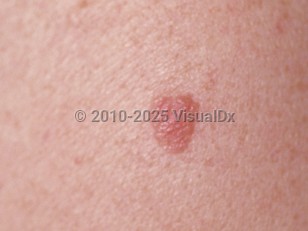Lichenoid keratosis
Alerts and Notices
Important News & Links
Synopsis

Lichenoid keratosis, also known as benign lichenoid keratosis (BLK), solitary lichenoid keratosis (SLK), lichen planus-like keratosis (LPLK), solitary lichen planus, or involuting lichenoid plaque, is an asymptomatic or mildly pruritic pink papule or plaque commonly found on sun-exposed areas. While lichenoid keratoses can appear anywhere on the skin, the most common location is the trunk. These lesions also frequently appear on extremities.
Clinically, lichenoid keratosis may simulate an actinic keratosis, basal cell carcinoma (eg, nodular or superficial), squamous cell carcinoma in situ, seborrheic keratosis, or a pigmented or amelanotic melanoma, whereas histologically it is almost identical to lichen planus.
The pathogenesis of lichenoid keratosis is not entirely understood, but it is thought to represent an inflammatory reaction occurring in a preexisting solar lentigo, seborrheic keratosis, or actinic keratosis.
Lichenoid keratoses are usually asymptomatic but may be slightly pruritic. Patients occasionally report that the lesion has changed, prompting examination of the lesion and biopsy. On average, the lesion has been present for 6 months at the time of diagnosis.
Most lichenoid keratoses are erythematous / pink, although some are violaceous or hyperpigmented. They are typically solitary and range in size from 3-19 mm in diameter. They may be scaly, pearly, or indurated.
Lichenoid keratoses often involute spontaneously over a period of months.
Clinically, lichenoid keratosis may simulate an actinic keratosis, basal cell carcinoma (eg, nodular or superficial), squamous cell carcinoma in situ, seborrheic keratosis, or a pigmented or amelanotic melanoma, whereas histologically it is almost identical to lichen planus.
The pathogenesis of lichenoid keratosis is not entirely understood, but it is thought to represent an inflammatory reaction occurring in a preexisting solar lentigo, seborrheic keratosis, or actinic keratosis.
Lichenoid keratoses are usually asymptomatic but may be slightly pruritic. Patients occasionally report that the lesion has changed, prompting examination of the lesion and biopsy. On average, the lesion has been present for 6 months at the time of diagnosis.
Most lichenoid keratoses are erythematous / pink, although some are violaceous or hyperpigmented. They are typically solitary and range in size from 3-19 mm in diameter. They may be scaly, pearly, or indurated.
Lichenoid keratoses often involute spontaneously over a period of months.
Codes
ICD10CM:
L43.9 – Lichen planus, unspecified
SNOMEDCT:
403198004 – Lichenoid actinic keratosis
L43.9 – Lichen planus, unspecified
SNOMEDCT:
403198004 – Lichenoid actinic keratosis
Look For
Subscription Required
Diagnostic Pearls
Subscription Required
Differential Diagnosis & Pitfalls

To perform a comparison, select diagnoses from the classic differential
Subscription Required
Best Tests
Subscription Required
Management Pearls
Subscription Required
Therapy
Subscription Required
References
Subscription Required
Last Reviewed:08/12/2019
Last Updated:08/12/2019
Last Updated:08/12/2019
Lichenoid keratosis

